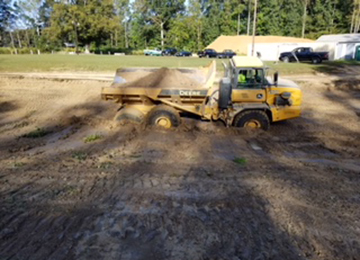With 2018 going on record as one of the wettest years in recent history, many contractors and owners are wondering how to perform earthwork in these adverse conditions. Weather events occurring every few days, as we have seen much of this year, have put many projects behind schedule and over budget. This can be very distressing to both contractors and owners. Their big question for the geotechnical engineer is “What can we do to help keep the project moving and have the smallest impact on the project budget?”
Wet soils can be manipulated in a variety of ways to help them dry. The soils’ moisture content has a direct impact on the contractor’s ability to place and compact soils properly. If the soil is too wet, it will not be suitable for placement and compaction (think about trying to compact wet soils/mud in your hand and how it falls apart). Typical construction methods for manipulating wet soils include:
1) Leave soils to aerate and dry without manipulation – This method doesn’t require equipment and is the least expensive option. However, favorable weather conditions must be forecast (often for several days in a row) to utilize this method.
2) Soils can be mechanically manipulated with drying equipment – Mechanical manipulation of wet soils is a more expensive option, since discing or other types of equipment that can rip and manipulate as well as re-compact soils in place are required. This method also requires a dry weather forecast to be effective.
3) Soils can be chemically modified with lime, cement or other additives – Chemical modification of wet soils with lime or cement to speed the drying process is typically more successful than the previously discussed options, since it is less weather sensitive. However, it is also more expensive, since it includes the cost of the additives, the mechanical equipment necessary to mix the soils and additives together, as well as re-compaction of the soil and additive mixture.
4) Remove and replace the soils – Undercutting and replacing soils is the alternative that is least impacted by weather. However, it is by far the most expensive option. In addition to the cost of replacement soil materials, the undercut soils must also be discarded.
A geotechnical engineer who is familiar with local soil types and how best to deal with those soils when they are wet is critical to keeping the project on schedule and within budget. Team discussions involving the owner, geotechnical engineer, and contractor are critical to choosing the appropriate soil drying or replacement method for each project.

